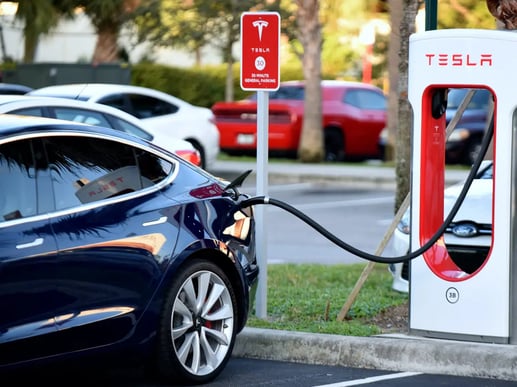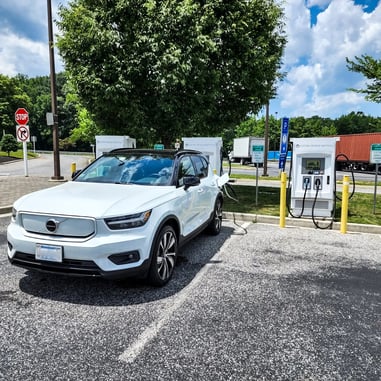Charging at Tesla Superchargers with a Ford Electric Car
Just over a year ago, we wrote about how General Motors and Ford electric vehicle (EV) drivers would soon have...
Big news in the electric car world over the past couple of weeks! Tesla has struck a partnership with both Ford and General Motors to allow their vehicles access to Tesla’s network of over 12,000 (and counting) Superchargers.
This is a huge development. It’s great for drivers of Ford and Chevy and the other GM brands, because one of Tesla’s key advantages in the electric car market is its expansive and reliable charging network. It also fundamentally shakes up the trajectory of the EV market, which seemed to have been settling on the CCS standard for DC fast charging (for non-Tesla vehicles) and is now settling on Tesla’s technology. (Don’t know what some of those terms mean? Check out our Charging Basics page.)
 Existing Ford and GM electric vehicle customers will have access to the Tesla Superchargers across the US and Canada starting in spring 2024. Tesla is developing an adapter for GM and Ford models (which currently use the J1772 Combo/CCS port for fast charging) to access Tesla’s Superchargers. To be clear, the access will be only for GM and Ford’s all-electric vehicle customers: Ford’s Mustang Mach-E, F-150 Lightning, and E-Transit; GM’s Cadillac Lyriq, Chevy Bolt, and forthcoming Equinox and Blazer. (Most plug-in hybrid vehicles do not have fast-charging capabilities; none of GM’s or Ford’s do.) Crucially, we don’t yet know when the adapter will be available or how much it will cost.
Existing Ford and GM electric vehicle customers will have access to the Tesla Superchargers across the US and Canada starting in spring 2024. Tesla is developing an adapter for GM and Ford models (which currently use the J1772 Combo/CCS port for fast charging) to access Tesla’s Superchargers. To be clear, the access will be only for GM and Ford’s all-electric vehicle customers: Ford’s Mustang Mach-E, F-150 Lightning, and E-Transit; GM’s Cadillac Lyriq, Chevy Bolt, and forthcoming Equinox and Blazer. (Most plug-in hybrid vehicles do not have fast-charging capabilities; none of GM’s or Ford’s do.) Crucially, we don’t yet know when the adapter will be available or how much it will cost.
Starting in 2025 (it’s unclear so far whether that is calendar year 2025 or model year 2025), all new GM and Ford electric vehicles will come standard with the North American Charging Standard (NACS) (aka the Tesla Charging Port) built in. This means no more adapters!
Both Ford and GM plan to integrate the Tesla charging stations into their brand-specific apps: FordPass and myChevrolet. The timing of this integration is to be determined.
A while back, we wrote about how Tesla was opening up some of its superchargers to non-Tesla drivers with a “magic” port, thanks to an agreement with the White House. This new opening-up also has to do with federal policy.
The Bipartisan Infrastructure Law that set up the National Electric Vehicle Infrastructure (NEVI) program required that the EV charging stations it funds “must be non-proprietary, allow for open-access payment methods, be publicly available or available to authorized commercial motor vehicle operators from more than one company.” Before these most recent announcements, that meant Tesla could access NEVI funds as long as it built stations that also had CCS chargers available.
Back in November 2022, Tesla made the design of its NACS charger open to the public. In its announcement, Tesla explicitly wrote: “We invite charging network operators and vehicle manufacturers to put the Tesla charging connector and charge port, now called the North American Charging Standard (NACS), on their equipment and vehicles.” That opened the door for Ford and GM to begin incorporating the standards into their designs.
Fast-forward to today, and we see this strategic partnership among rivals. Tesla benefits because its chargers will see more use, its technology took two huge steps closer to winning the market, and it can now access NEVI funds without having to also build CCS chargers. Ford and GM benefit too, not just because consumers will be able to buy their products with more confidence in their ability to find charging: it also saves the companies money. GM, for example, was planning to spend $750 million to help build out the DC fast charging for its customers. Now, CEO Mary Barra has said they’re saving $400 million on this endeavor.

Overall, settling on a standard is a more efficient use of charging infrastructure. If we, as a society, are going to make the investment to build out DC Fast Charging stations (and we must!), then it’s best to have those stations well-used (not underused or overcrowded).
 We really can’t stress enough how huge this news is.
We really can’t stress enough how huge this news is.
This partnership will exert a lot of pressure on other competitors to get on the bandwagon. If you are Nissan, Toyota, or Honda, and you suddenly see three of your biggest competitors joining forces for a new charging standard that has many more chargers available than the standard your vehicles use, how can you make the case for drivers to choose your vehicles?
This announcement also fundamentally impacts those companies who have made a business out of building out non-Tesla charging stations: ChargePoint, EVgo, Electrify America, and the like. Until now, they have not had to directly compete with Tesla, because the market was so segmented. Now, a huge chunk of the customers that had been theirs will have the choice to opt for NACS stations in 2024 - and they themselves have the choice to start building out NACS stations. How will that impact their strategies?
There's also more to a charger than just the hardware - there are software, communications, and data protocols inherent in these standards. From what we have read, Tesla has opened up the NACS hardware plans but not shared its proprietary communications software with its competitors. That means that charging stations run by Tesla will likely "speak the language" of both Tesla/NACS and CCS communications and that non-Tesla car manufacturers and charging providers will build out charging stations with NACS hardware that "speak" CCS. This is all very new news with a lot of speculation and we'll see how this plays out. In any case, this will have huge implications for how charging data is collected, transmitted, stored, and managed.
For one example, the CCS standard was working towards being vehicle-to-grid (V2G) capable. Ford has made a big deal out of the F-150 Lightning’s V2G capabilities. Tesla, though, has been more reluctant on the V2G front (perhaps because they’d also like to sell you a Powerwall?). What will this new partnership mean for the future of V2G? At Green Energy Consumers, we are strong advocates for V2G, so we hope that this issue will be resolved to the benefit of consumers.
Long story short, there’s a reason Tesla calls its charging port the North American Charging Standard (NACS); Tesla wants its charging port to be the universal standard in North America. But it will have to make many more partnerships with auto manufacturers to do so. For now, people who want to drive a Ford or GM electric car will have a much easier time finding fast chargers on road trips. For the rest, we’ll have to wait to see how this plays out.
P.S. As of June 20, 2023, Rivian has announced its partnership with Tesla and will be following the same timeline.
Just over a year ago, we wrote about how General Motors and Ford electric vehicle (EV) drivers would soon have...
For years, one of the unique advantages of being a Tesla driver has been having access to Tesla’s widespread and...
Comments